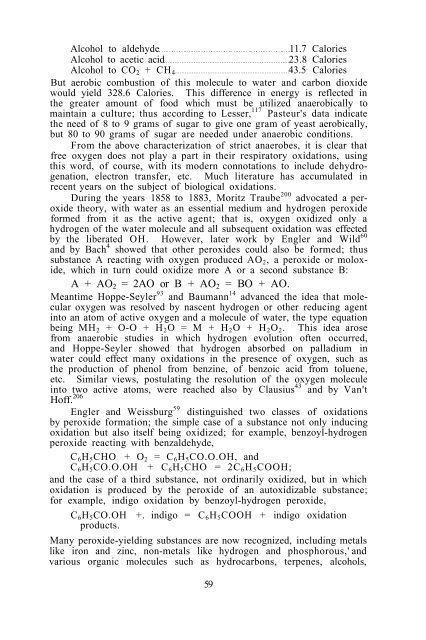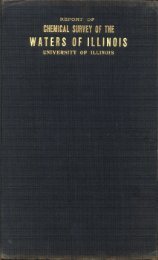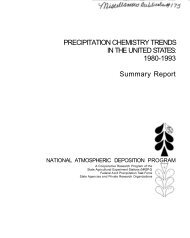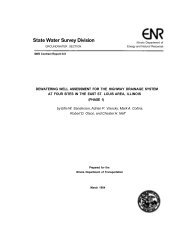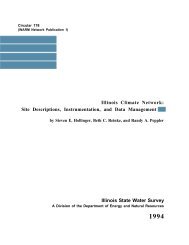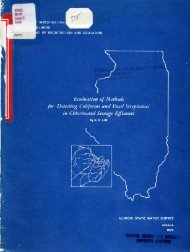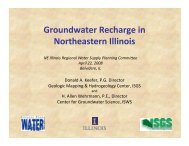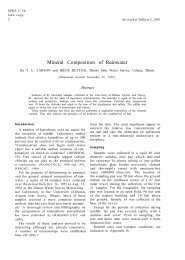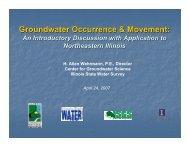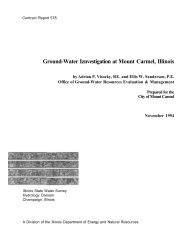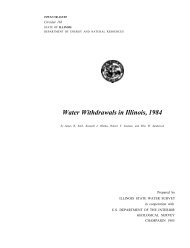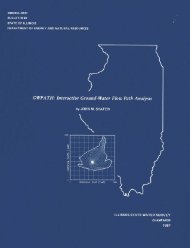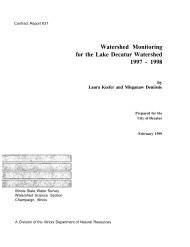Laboratory studies of sludge digestion. - Illinois State Water Survey
Laboratory studies of sludge digestion. - Illinois State Water Survey
Laboratory studies of sludge digestion. - Illinois State Water Survey
Create successful ePaper yourself
Turn your PDF publications into a flip-book with our unique Google optimized e-Paper software.
Alcohol to aldehyde 11.7 Calories<br />
Alcohol to acetic acid 23.8 Calories<br />
Alcohol to CO2 + CH4<br />
43.5 Calories<br />
But aerobic combustion <strong>of</strong> this molecule to water and carbon dioxide<br />
would yield 328.6 Calories. This difference in energy is reflected in<br />
the greater amount <strong>of</strong> food which must be utilized anaerobically to<br />
maintain a culture; thus according to Lesser, 117 Pasteur's data indicate<br />
the need <strong>of</strong> 8 to 9 grams <strong>of</strong> sugar to give one gram <strong>of</strong> yeast aerobically,<br />
but 80 to 90 grams <strong>of</strong> sugar are needed under anaerobic conditions.<br />
From the above characterization <strong>of</strong> strict anaerobes, it is clear that<br />
free oxygen does not play a part in their respiratory oxidations, using<br />
this word, <strong>of</strong> course, with its modern connotations to include dehydrogenation,<br />
electron transfer, etc. Much literature has accumulated in<br />
recent years on the subject <strong>of</strong> biological oxidations.<br />
During the years 1858 to 1883, Moritz Traube 200 advocated a peroxide<br />
theory, with water as an essential medium and hydrogen peroxide<br />
formed from it as the active agent; that is, oxygen oxidized only a<br />
hydrogen <strong>of</strong> the water molecule and all subsequent oxidation was effected<br />
by the liberated OH. However, later work by Engler and Wild 60<br />
and by Bach 4 showed that other peroxides could also be formed; thus<br />
substance A reacting with oxygen produced AO2, a peroxide or moloxide,<br />
which in turn could oxidize more A or a second substance B:<br />
A + AO2 = 2AO or B + AO2 = BO + AO.<br />
Meantime Hoppe-Seyler 93 and Baumann 14 advanced the idea that molecular<br />
oxygen was resolved by nascent hydrogen or other reducing agent<br />
into an atom <strong>of</strong> active oxygen and a molecule <strong>of</strong> water, the type equation<br />
being MH2 + O-O + H2O = M + H2O + H2O2. This idea arose<br />
from anaerobic <strong>studies</strong> in which hydrogen evolution <strong>of</strong>ten occurred,<br />
and Hoppe-Seyler showed that hydrogen absorbed on palladium in<br />
water could effect many oxidations in the presence <strong>of</strong> oxygen, such as<br />
the production <strong>of</strong> phenol from benzine, <strong>of</strong> benzoic acid from toluene,<br />
etc. Similar views, postulating the resolution <strong>of</strong> the oxygen molecule<br />
into two active atoms, were reached also by Clausius 43 and by Van't<br />
H<strong>of</strong>f. 206<br />
Engler and Weissburg 59 distinguished two classes <strong>of</strong> oxidations<br />
by peroxide formation; the simple case <strong>of</strong> a substance not only inducing<br />
oxidation but also itself being oxidized; for example, benzoyl-hydrogen<br />
peroxide reacting with benzaldehyde,<br />
C6H5CHO + O2 = C6H5CO.O.OH, and<br />
C6H5CO.O.OH + C6H5CHO = 2C6H5COOH;<br />
and the case <strong>of</strong> a third substance, not ordinarily oxidized, but in which<br />
oxidation is produced by the peroxide <strong>of</strong> an autoxidizable substance;<br />
for example, indigo oxidation by benzoyl-hydrogen peroxide,<br />
C6H5CO.OH +. indigo = C6H5COOH + indigo oxidation<br />
products.<br />
Many peroxide-yielding substances are now recognized, including metals<br />
like iron and zinc, non-metals like hydrogen and phosphorous,' and<br />
various organic molecules such as hydrocarbons, terpenes, alcohols,<br />
59


